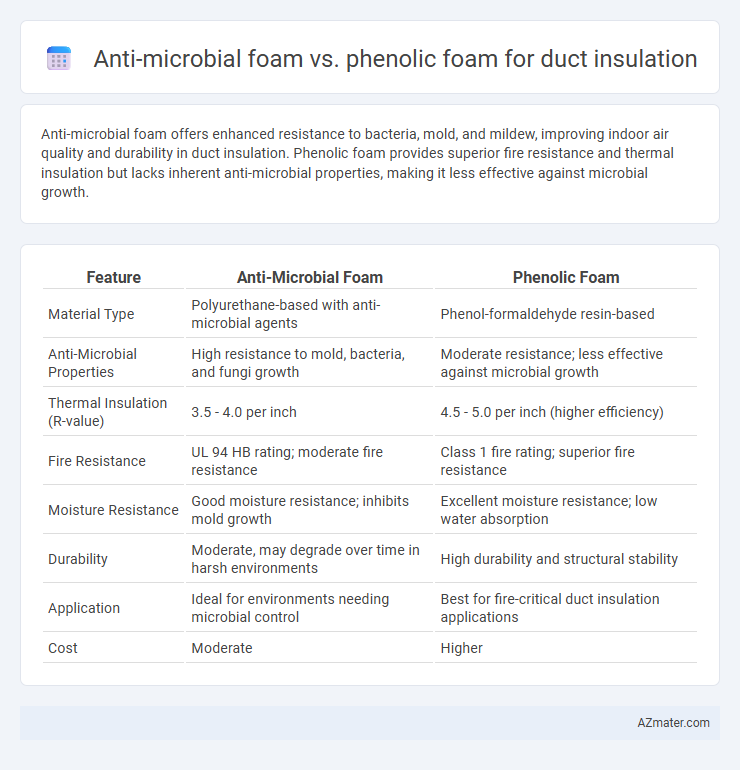Anti-microbial foam offers enhanced resistance to bacteria, mold, and mildew, improving indoor air quality and durability in duct insulation. Phenolic foam provides superior fire resistance and thermal insulation but lacks inherent anti-microbial properties, making it less effective against microbial growth.
Table of Comparison
| Feature | Anti-Microbial Foam | Phenolic Foam |
|---|---|---|
| Material Type | Polyurethane-based with anti-microbial agents | Phenol-formaldehyde resin-based |
| Anti-Microbial Properties | High resistance to mold, bacteria, and fungi growth | Moderate resistance; less effective against microbial growth |
| Thermal Insulation (R-value) | 3.5 - 4.0 per inch | 4.5 - 5.0 per inch (higher efficiency) |
| Fire Resistance | UL 94 HB rating; moderate fire resistance | Class 1 fire rating; superior fire resistance |
| Moisture Resistance | Good moisture resistance; inhibits mold growth | Excellent moisture resistance; low water absorption |
| Durability | Moderate, may degrade over time in harsh environments | High durability and structural stability |
| Application | Ideal for environments needing microbial control | Best for fire-critical duct insulation applications |
| Cost | Moderate | Higher |
Overview of Duct Insulation Materials
Anti-microbial foam offers superior resistance to bacterial and fungal growth, making it ideal for maintaining indoor air quality in HVAC duct systems. Phenolic foam provides excellent thermal insulation with low smoke emission and fire resistance, enhancing safety in duct applications. Both materials contribute to energy efficiency but differ in moisture resistance and microbial inhibition, influencing their suitability based on environmental requirements.
What is Anti-Microbial Foam?
Anti-microbial foam for duct insulation is a specialized material treated with agents that inhibit mold, bacteria, and fungal growth, enhancing indoor air quality and extending the lifespan of HVAC systems. Compared to phenolic foam, which primarily offers high thermal insulation and fire resistance, anti-microbial foam provides superior protection against biological contaminants, making it ideal for environments prone to moisture and microbial buildup. Its unique composition not only insulates ducts effectively but also maintains a healthier airflow by preventing microbial infestation.
Understanding Phenolic Foam Insulation
Phenolic foam insulation offers superior thermal performance with a low thermal conductivity of approximately 0.020 W/m*K, making it highly efficient for duct insulation. Its closed-cell structure provides excellent moisture resistance and fire retardant properties, reducing microbial growth compared to conventional materials. Unlike anti-microbial foam that primarily inhibits microbial activity, phenolic foam delivers combined benefits of insulation, fire safety, and durability, enhancing HVAC system efficiency and air quality.
Thermal Performance Comparison
Anti-microbial foam offers superior thermal performance for duct insulation due to its enhanced resistance to microbial growth, which maintains its insulation properties over time. Phenolic foam provides consistent thermal insulation with low thermal conductivity (around 0.020 W/m*K), but it can be susceptible to moisture absorption, potentially compromising its efficiency. The long-term thermal stability of anti-microbial foam ensures reduced heat loss and energy consumption in HVAC systems compared to phenolic foam under similar environmental conditions.
Moisture Resistance and Mold Prevention
Anti-microbial foam offers superior moisture resistance and mold prevention for duct insulation due to its embedded antimicrobial agents that inhibit microbial growth on the surface and within the material. In contrast, phenolic foam, while providing good thermal insulation, is more susceptible to moisture absorption, increasing the risk of mold development inside ducts over time. Selecting anti-microbial foam enhances the longevity and hygiene of HVAC systems by reducing condensation-related mold issues and maintaining better indoor air quality.
Fire Safety and Smoke Emissions
Anti-microbial foam for duct insulation offers enhanced microbial resistance but generally has lower fire-retardant properties compared to phenolic foam, which is known for its excellent fire safety performance with a high limiting oxygen index (LOI) above 35%. Phenolic foam significantly reduces smoke emissions during combustion, producing less toxic gases and smoke density, aligning with stringent fire safety standards in HVAC applications. Selecting phenolic foam improves overall fire safety by minimizing flame spread and smoke hazards, critical factors in duct insulation for commercial and industrial buildings.
Longevity and Durability
Anti-microbial foam for duct insulation offers enhanced resistance to mold, bacteria, and fungi, significantly extending its lifespan in humid or contaminated environments. Phenolic foam provides excellent thermal insulation with inherent fire resistance, but it may degrade faster under prolonged moisture exposure compared to anti-microbial foam. Longevity and durability depend on environmental conditions, with anti-microbial foam outperforming phenolic foam in moisture-prone duct systems due to its microbial resistance properties.
Installation Process and Flexibility
Anti-microbial foam offers easier installation due to its lightweight and flexible nature, allowing it to conform to complex duct shapes without cracking or breaking. Phenolic foam, while providing excellent thermal insulation and fire resistance, is more rigid and requires precise cutting and fitting, which can extend installation time and complicate adjustments. The flexibility of anti-microbial foam reduces labor costs and installation errors compared to the more brittle and less forgiving phenolic foam.
Cost Analysis: Anti-Microbial vs Phenolic Foam
Anti-microbial foam generally costs 15-30% more per cubic foot compared to phenolic foam due to its specialized biocidal additives that prevent microbial growth in duct insulation. Phenolic foam offers a lower initial investment with strong thermal insulation and fire-resistant properties, making it cost-effective for large-scale HVAC projects aimed at energy efficiency. Long-term cost savings with anti-microbial foam arise from reduced maintenance and mold remediation expenses, especially in environments prone to moisture and contamination.
Environmental Impact and Sustainability
Anti-microbial foam offers enhanced resistance to mold and bacteria, reducing maintenance needs and prolonging duct lifespan, which positively impacts environmental sustainability by minimizing waste. Phenolic foam provides superior thermal insulation and fire resistance, often manufactured with lower global warming potential (GWP) blowing agents, contributing to a reduced carbon footprint. Both materials support energy efficiency in HVAC systems, but phenolic foam generally ranks higher in eco-friendly certifications due to its lower environmental impact during production and disposal.

Infographic: Anti-microbial foam vs Phenolic foam for Duct Insulation
 azmater.com
azmater.com